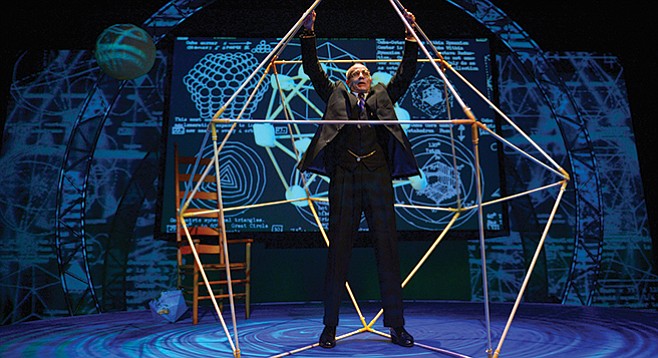 Facebook
Facebook
 X
X
 Instagram
Instagram
 TikTok
TikTok
 Youtube
Youtube

Does anyone remember who R. Buckminster Fuller was? I must admit that my knowledge of him was limited to remembering that he was something of an innovative thinker from the past.
Just the other evening I was introduced to “Bucky” Fuller down at The Lyceum Theater in Horton Plaza. R. Buckminster Fuller: The History (and Mystery) of the Universe, produced by San Diego Repertory Theater ran through April 3.
This one-man show is more than an impersonation of Buckminster Fuller. The show is an exegesis of Fuller’s thought disguised as a biopic. I heard echoes of Eastern Thought expressed in a Western dialect. The mysteries of Egypt came to my mind as 20th-century geometry drew me into a narrative that I couldn’t have possibly been interested in before entering the theater. Yet there I was on the edge of my seat watching in awe as the grandeur of the cosmos descended upon me. Or did it ascend from the quantum field? Did Fuller discover in this century something that was merely forgotten? Why was the square considered the basis of geometry when clearly it’s the triangle (illuminati confirmed)?
I say “clearly it’s the triangle” as if I knew that going in. I did not, but it was one of those “of course” ideas — kind of like ketchup in a squeeze bottle, or two wheels on the stable side of a suitcase instead of four on the wobbly side.
What I didn’t expect was any kind of an emotional experience. I was expecting a TED Talk. What I got was an intimate chat that turned my thoughts and feelings inward toward the nature of consciousness.
Fuller made a distinction between “brain” and “mind.” His distinction was not new. This version of dualism goes back to Descartes in the 17th Century and ever further back in philosophies such as Taoism where Yin and Yang represent a duality.
Fuller’s distinction is probably most similar to that of the Samkhya system in Hindu thought. Samkhya dates back to as early as 1500 B.C. and makes a distinction between Purusa and Prakiti. Purusa is pure consciousness in which Prakriti arises. He is the mirror in which her reflection dances. Prakriti is the physical world but also includes what we might consider to be nonphysical elements such as thoughts and emotions.
Buckminster Fuller asked the eternal question that many of us never take the time to consider. What is consciousness or, to use his term, mind? What is it? What is it that is behind our eyes looking out?
Take your time answering that one, we’ve had at least 3500 years to crack the nut of consciousness, and we’re still waiting.


Does anyone remember who R. Buckminster Fuller was? I must admit that my knowledge of him was limited to remembering that he was something of an innovative thinker from the past.
Just the other evening I was introduced to “Bucky” Fuller down at The Lyceum Theater in Horton Plaza. R. Buckminster Fuller: The History (and Mystery) of the Universe, produced by San Diego Repertory Theater ran through April 3.
This one-man show is more than an impersonation of Buckminster Fuller. The show is an exegesis of Fuller’s thought disguised as a biopic. I heard echoes of Eastern Thought expressed in a Western dialect. The mysteries of Egypt came to my mind as 20th-century geometry drew me into a narrative that I couldn’t have possibly been interested in before entering the theater. Yet there I was on the edge of my seat watching in awe as the grandeur of the cosmos descended upon me. Or did it ascend from the quantum field? Did Fuller discover in this century something that was merely forgotten? Why was the square considered the basis of geometry when clearly it’s the triangle (illuminati confirmed)?
I say “clearly it’s the triangle” as if I knew that going in. I did not, but it was one of those “of course” ideas — kind of like ketchup in a squeeze bottle, or two wheels on the stable side of a suitcase instead of four on the wobbly side.
What I didn’t expect was any kind of an emotional experience. I was expecting a TED Talk. What I got was an intimate chat that turned my thoughts and feelings inward toward the nature of consciousness.
Fuller made a distinction between “brain” and “mind.” His distinction was not new. This version of dualism goes back to Descartes in the 17th Century and ever further back in philosophies such as Taoism where Yin and Yang represent a duality.
Fuller’s distinction is probably most similar to that of the Samkhya system in Hindu thought. Samkhya dates back to as early as 1500 B.C. and makes a distinction between Purusa and Prakiti. Purusa is pure consciousness in which Prakriti arises. He is the mirror in which her reflection dances. Prakriti is the physical world but also includes what we might consider to be nonphysical elements such as thoughts and emotions.
Buckminster Fuller asked the eternal question that many of us never take the time to consider. What is consciousness or, to use his term, mind? What is it? What is it that is behind our eyes looking out?
Take your time answering that one, we’ve had at least 3500 years to crack the nut of consciousness, and we’re still waiting.
Comments